At Home
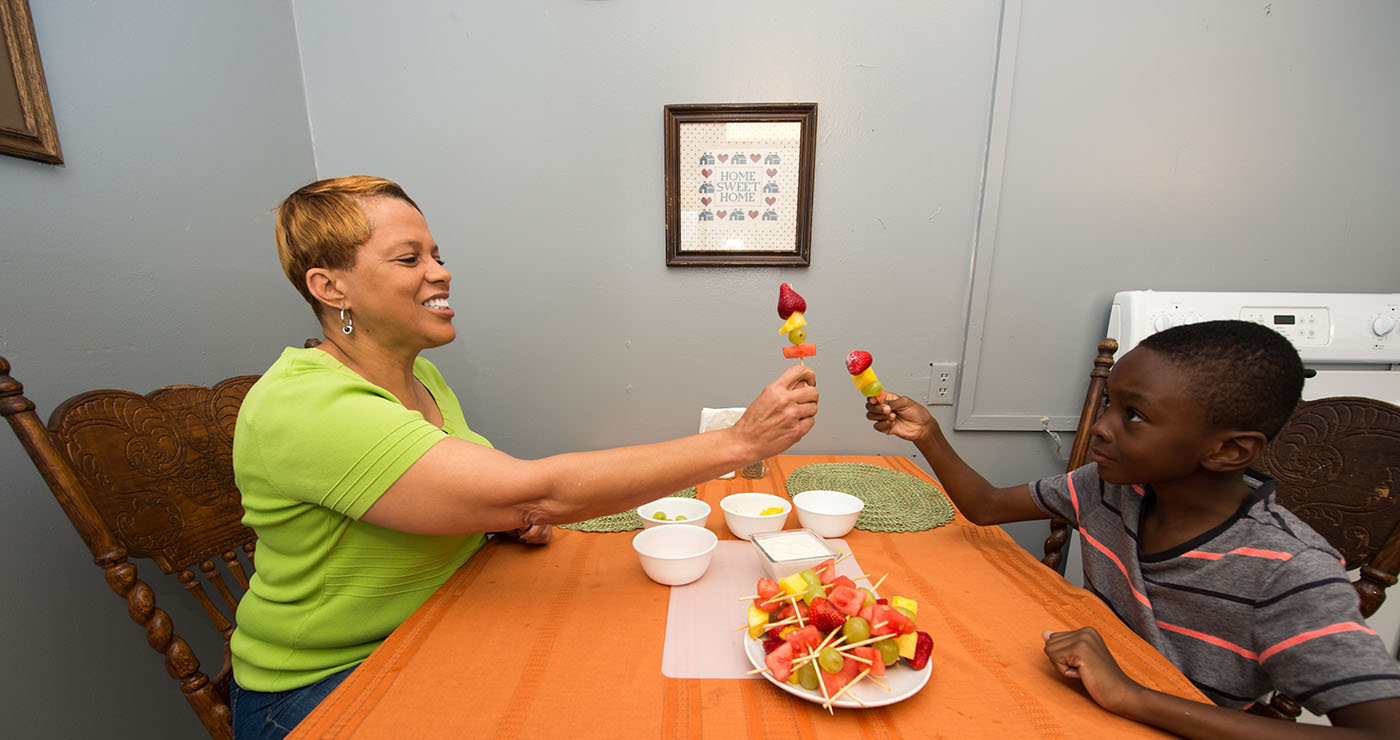
Be proud of the healthy food you serve!
Food nourishes our bodies, but it also nourishes our souls.
Food reminds us of family, of history, of traditions, of happy times and the places and people we love.
Food is where we’re from, our place, our people.
Food is who we are.
Food is love
In Mississippi, we show people we love them by feeding them—by nourishing their bodies and their souls.
We want them to be happy, and we want them to be healthy, too.
With HappyHealthy recipes, you can be proud of the healthy food you serve your family and friends, for holidays or for everyday.
You can make the foods that your family and friends love, but in healthier ways.
You can keep on feeding them and loving them—and know you’re keeping them healthy, too!
Keeping the tradition alive
Children learn to cook from you, by watching their elders.
Let children and grandchildren, nieces and nephews help you in the kitchen. Let them do simple tasks like measuring or stirring.
Tell them your family stories. Talk to them about your traditional recipes and ways you are making them healthier.
Sit at the table together, and savor every delicious bite.
Celebrate holidays and special times with dancing, sports, or games that keep you moving, in addition to a special meal.
You will have wonderful new traditions that will keep your family happy and healthy for generations to come!
Eating Together Matters

Research shows:
Kids who eat meals with their families are:
- 4 times less likely to smoke.
- 3 times less likely to use marijuana.
- 2 times less likely to drink alcohol.
Better Grades
Studies show that kids from elementary school to high school who ate dinner with their families more than 4 times a week had better test scores. Young children and babies who listened to parents around the table improved their language skills, too.
Healthier Bodies
In addition to limiting TV time and getting enough sleep, kids who eat meals with family members are more confident and stay at a healthy weight.
Tips for Family Meals
Your kids learn from you. Your children watch what you do. At the table, if your kids see you enjoying a healthy meal, they will follow in your footsteps. So choose healthy!
Conversation time. Because everyone gathers together, meal times are the perfect times to sit down and talk as a family. Remember to talk positively, but honestly. Discuss problems at some other place and time.
No electronics. Televisions, phones, tablets, and computers are a real distraction from quality time with the family. Meal times should encourage person-to-person conversation.
Get your family involved. Everyone should be a part of meal time. Let everyone participate in shopping for groceries, cooking, eating, and cleaning up afterwards!
Choices. You shouldn’t have to cook around picky eaters, but you can give kids options between which fruits or vegetables they would like. This will make them more willing to eat what they’ve chosen.
Make the healthy choice, the easy choice. Keep fresh fruit and vegetables on hand and within reach as healthy and delicious snacks. If your family eats healthy, so will your kids.
Enjoy. Food isn’t the only thing to enjoy at meals. Eating meals together helps to improve family connections. Savor every moment and every delicious bite!
Breakfast Together

BREAKFAST IS IMPORTANT
SOME THINGS ARE JUST BETTER TOGETHER. LIKE BREAKFAST.
IT HELPS KIDS GROW, LEARN, AND PLAY.
Better Breakfast Tips:
- Start small. Eating together once or twice a week makes a difference.
- Add fruit. Choose fresh fruit in season, frozen, or canned in water or juice.
- Choose milk. Plain, low-fat (1%) milk is best for children over age two.
- Save time. Get ready for morning. Make breakfast the night before.
Breakfast Together
Why Breakfast Matters
Breakfast is the most important meal of the day, especially for children and teenagers.
Children who eat breakfast do better in school and feel better throughout the day.
Sitting down with your children helps them feel confident and connect with you.
Weekends (or days that you and your family are free) are good times have breakfast together.
How to Start
- Baby steps. Don’t expect your family to start eating breakfast together every day. Start out with a small goal—once or twice a week—and move up from there.
- Simple is good. Breakfast doesn’t have to be gourmet. Something as easy as oatmeal can be made ahead of time, reheated, and eaten together as a family.
- Time to relax. Meals are a good time to get away from distractions like TV, phones, and video games. Take time to relax in the morning with your family before you start your day.
- Get involved. Let your family get involved with shopping, cooking, and cleaning. This will give your family more time to bond. Being a part of food decisions will also make your family more willing to eat together and enjoy it.
- Table Talk. Meals should be a time for your family to relax and bond. Problems should be discussed away from the table.
Breakfast Five by Five

Breakfast Five by Five
Here is a 5-by-5 take on quick ways to get the day off to a great start for yourself or your whole family!
Toast FIVE Ways
- Bite into whole-grain toast topped with peanut butter, a spoonful of honey, and fruit that is on sale. Instead of bread, you can toast a whole-wheat waffle.
- Try low-fat cottage cheese instead of cream cheese on your toast. Drizzle jelly and a handful of your favorite nuts on top. Add a piece of fruit on the side.
- Make a breakfast pizza! On a tortilla, pile a handful of your favorites from this list: tomato sauce (or fresh/canned tomato slices), cheese, onions, lettuce, peppers, mushrooms, beans, or salsa. Melt everything on top in the microwave or toaster oven.
- Top a slice of toast with three big spoonfuls of low-fat cottage cheese, a tomato slice, a couple of avocado slices, and a pinch of salt and pepper.
- Try mashed bananas on toast. Just mash ½ banana with a fork, and spoon it on a toasted English muffin. As a side, have string cheese or a hard-boiled egg.
Oatmeal FIVE ways
- Slice half a banana for your oatmeal. When cooked, it makes your oatmeal grow into a bigger portion without a lot of extra calories. Because of the fruit’s sweetness, add less sugar. Add a teaspoon each of vanilla extract and cinnamon to boost the flavor.
- Cook oatmeal in water. Afterwards, add two big spoonfuls of low-fat, plain yogurt with a pinch of cinnamon.
- In-season fruits are less expensive. Find them under “sale” signs at your grocery store. Frozen and canned fruits (in water or own juice) are good all year long! Put these fruits in your oatmeal.
- For PB&J oatmeal, mix in a spoonful of nuts and a spoonful of jelly.
- If you’re making pancakes, mix oats into your batter.
Eggs FIVE ways
- Scramble eggs with spinach (fresh, frozen, or canned) and onions with fruit as a side. If using frozen spinach, thaw it and squeeze the water out first!
- Sandwich a fried or poached egg between a whole-wheat English Muffin. Stack on vegetables and a slice of cheese.
- Brown-shelled eggs are no better for you than white-shelled eggs. Stick to the cheaper variety and buy extra veggies to add to a burrito. If you don’t have fresh veggies on hand, scramble your eggs with salsa. Scoop it all into a tortilla.
- Leftover veggies from yesterday’s dinner? Heat them in a skillet and top them with two eggs and a spoonful of cheese. Then, spice up your dish with herbs or salsa.
- Mix eggs into your batter for pancakes, muffins, or French toast.
Fruit FIVE ways
- Look for price mark-downs on fresh fruits. These fruits will cost less during the months they are in season: citrus fruits will be cheaper in the winter, berries in the spring and summer, and apples in the fall.
- Frozen fruits are always cheap. Find them in the frozen foods section in the grocery store. When you’re ready to eat them, thaw the fruit on the counter, in the microwave, or in the refrigerator. Use them as a topping for pancakes, waffles, or cereal.
- At a farmer’s market, ask for “seconds.” These fruits are cheaper because they are mildly bruised or marked. Peel off the discolored parts and mix what’s left with low-fat plain yogurt. Add a spoonful of sugar, nuts, and a pinch of cinnamon.
- Cut fruit into small pieces for dipping into peanut butter, yogurt, or low-fat whipped cream! Buying pre-cut fruit is expensive.
- Make an edible bowl! Slice a small cantaloupe in half. Scoop out the seeds. Scoop in low-fat cottage cheese, cereal, and a spoonful of sugar.
Vegetables FIVE ways
- Sauté onions with sweet potato pieces. “Sauté” means using a spoonful or two of oil, butter, or another fat to cook your food in a skillet over medium heat on the stovetop.
- Keep the skins on your potatoes and slice them very thin. Sauté them with onions, garlic, and peppers.
- Fill an omelet with frozen or leftover vegetables.
- A quesadilla for breakfast? Try a six-inch whole-wheat tortilla stuffed with cheese and vegetables.
- Mix chopped, cooked veggies into your scrambled eggs. Top with a spoonful of grated cheese.
Snacks Together

Eat Snacks Together
Not everyone can eat a family meal around a table three times a day.
If you can’t squeeze in mealtime, fit in some snacks!
It doesn’t have to be fancy as long as you eat together!
HOW TO START
Go slowly. Try to snack together once or twice a week in the beginning.
Start simple. Preparing healthy snacks ahead of time can save you time. Store snacks until you’re ready to eat.
No electronics. Turning off all electronics will create a calm atmosphere for your family’s meal.
Get everyone involved. Let your family help you shop, choose their favorite healthy snack, set the table, or make the snack.
Relax and connect. Enjoy healthy foods while connecting with your family and friends.
THEY LEARN FROM WATCHING YOU.
Simply Healthy Combos
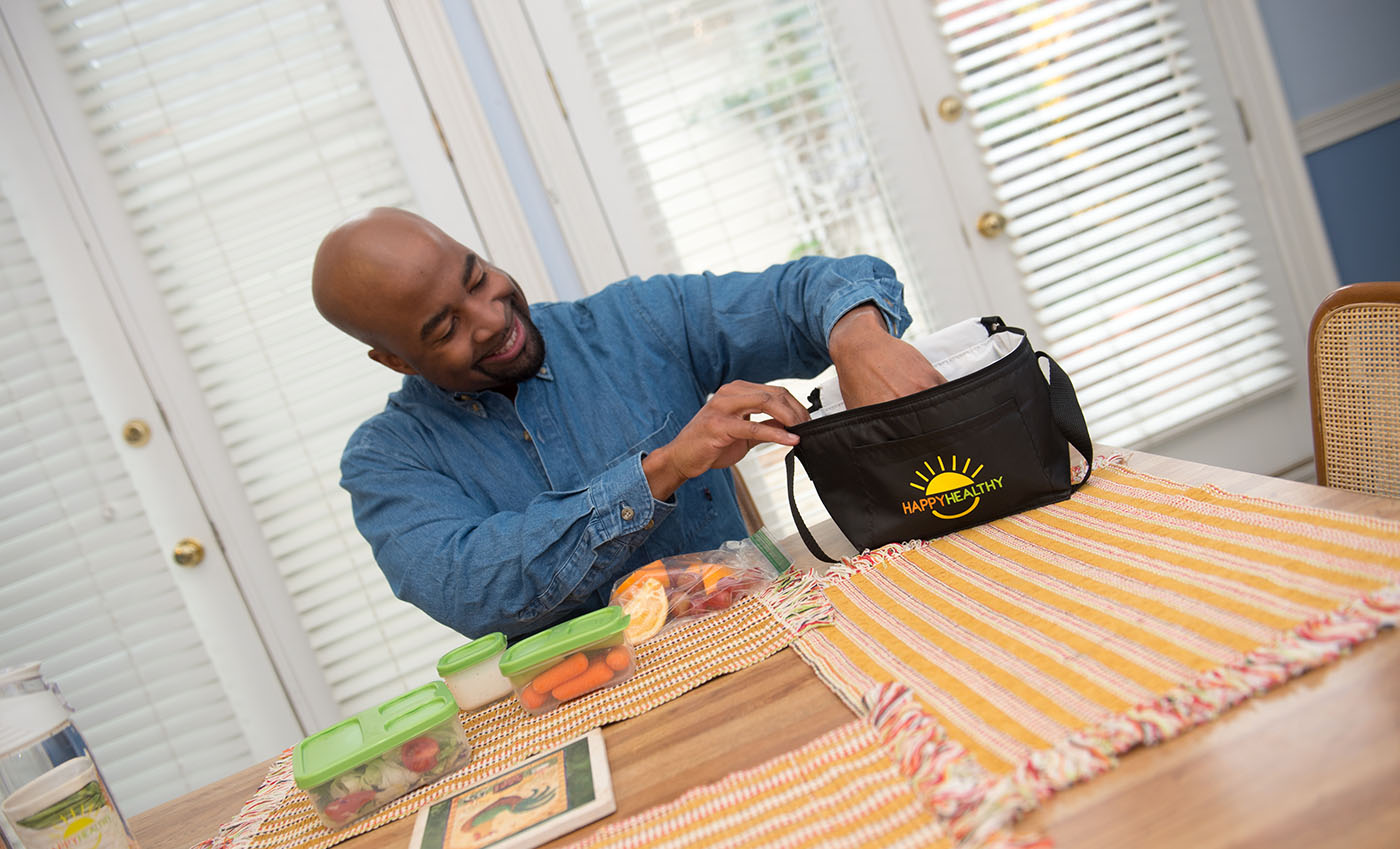
SIMPLY HEALTHY COMBOS
GRAPES WITH PB YOGURT DIP
Dip grapes in one cup low-fat vanilla yogurt mixed with a spoonful of peanut butter.
PRETZELS-N-CHEESE WITH DIP
Dip a handful of pretzels in honey mustard and add string cheese.
CHIPS WITH BLACK BEAN SALSA
Dip a handful of tortilla chips in salsa with black beans mixed in.
SOME THINGS ARE JUST BETTER TOGETHER. LIKE MAKING SIMPLE SNACKS.
GRAHAM CRACKER “CHEESECAKE”
Top a graham cracker with two spoonfuls of cottage cheese and a little jelly.
CHILI DUSTED MANGO
Top mango slices with a squeeze of lime juice and a pinch of chili powder.
BANANA SANDWICHES
Top banana slices with peanut butter and raisins.
SNACKS + YOU = SMILES
ANTS ON A LOG
5 stalks celery
½ cup peanut butter
¼ cup raisins
- Wash celery stalks
- Cut them in half
- Spread with peanut butter
- Sprinkle with raisins
MORE GREAT RECIPES
Lady Bugs on a Log
Cream cheese with dried cranberries or grapes.
Bumble Bees on a Log
Peanut butter with yellow raisins and chocolate chips.
Bugs Go to the Zoo
Yogurt with animal crackers.
Snack Tips for Parents
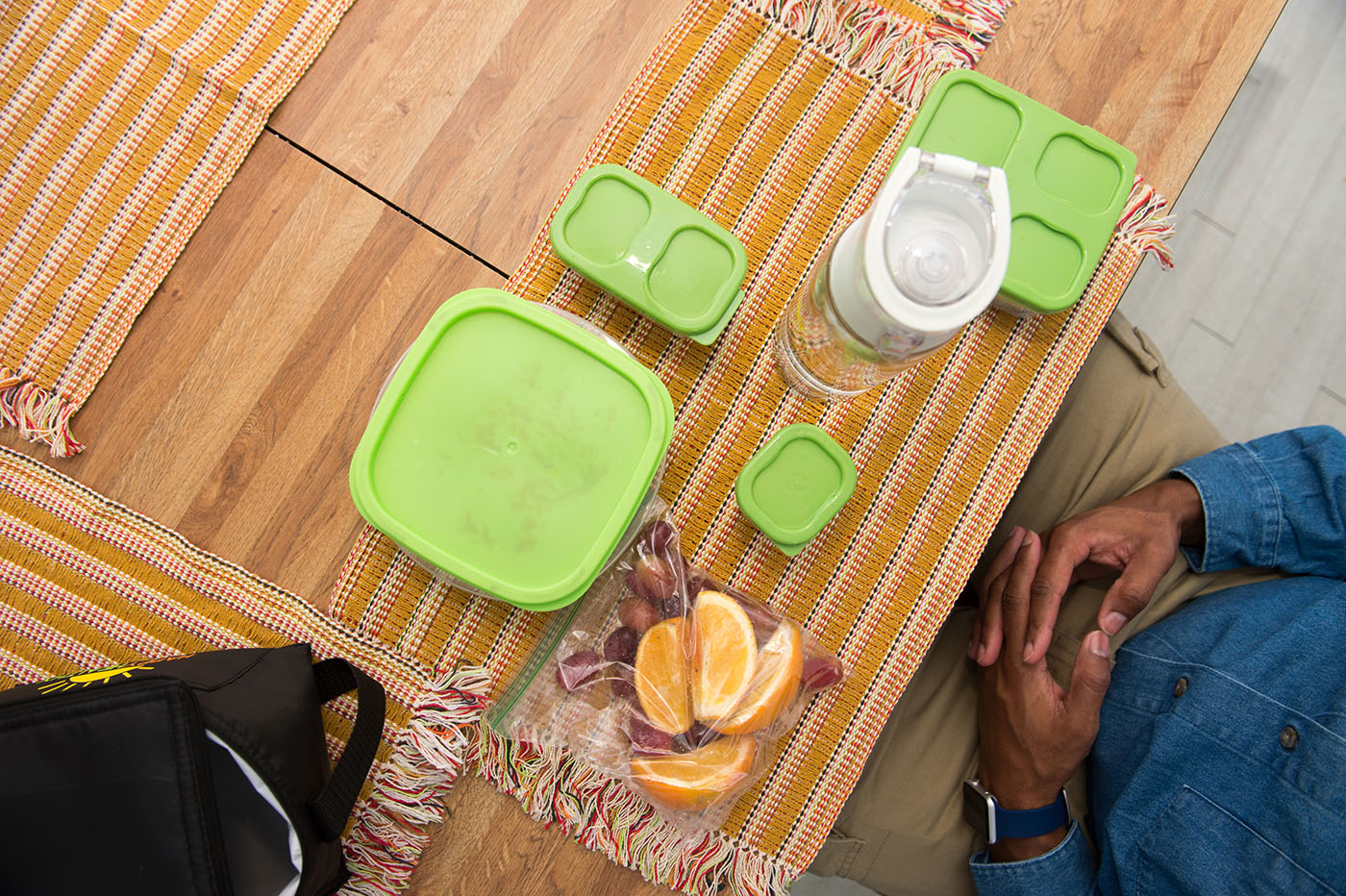
Snack Tips for Parents
Snacks can help children get the nutrients needed to grow. Prepare snacks that include two or more food groups. For younger children, help them get just enough to satisfy their hunger. Let older kids make their own snacks by keeping healthy foods in the kitchen. Visit ChooseMyPlate.gove to help you and your kids select a satisfying snack.
- Save time by slicing veggies
- Store sliced vegetables in the refrigerator and serve with hummus. Top half of a whole-wheat English muffin with spaghetti sauce, chopped vegetables, and low-fat shredded mozzarella and melt in the microwave.
- Mix it up
- For older school-age kids, mix dried fruit, unsalted nuts, and popcorn in a snack-size bag for a quick trail mix. Put fat-free yogurt, 100% fruit juice, and frozen peaches in a blender to make a tasty smoothie.
- Grab a glass of milk
- A cup of low-fat milk or fortified soy beverage is an easy way to drink a healthy snack.
- Go for great whole grains
- Offer whole-wheat breads, popcorn, and whole-oat cereals that are high in fiber and low in added sugars, saturated fat, and sodium. Limit refined-grain products such as snack bars, cakes, and sweetened cereals.
- Snack on protein foods.
- Choose protein foods such as unsalted nuts and seeds, hummus or other bean dips, and hard-cooked (boiled) eggs for a healthy, easy snack. Store hard-cooked eggs in the refrigerator for up to 1 week for kids to enjoy any time.
- Keep an eye on the size.
- Snacks shouldn't replace a meal, so look for ways to help your kids understand how much is enough. Store snack-size bags in the cupboard and use them to control serving sizes.
- Fruits are quick and easy.
- Fresh, frozen, dried, or canned fruits, such as applesauce, frozen grapes, or raisins, can be easy "grab-and-go" options that need little preparation. Offer whole fruit and limit the amount of 100% juice served. Choose canned fruits that are packed in 100% juice.
- Consider convenience.
- A single-serving container of low-fat yogurt or individually wrapped string cheese can be just enough for an after-school snack.
- Swap out the sugar
- Keep healthier foods handy so kids avoid cookies, pastries, or candies between meals. Add seltzer water to a 1/2 cup of 100% fruit juice instead of offering soda.
- Prepare homemade goodies.
- For homemade sweets, add dried fruits like apricots or raisins and reduce the amount of sugar in the recipe. Adjust recipes that include fats like butter or shortening by using unsweetened applesauce or prune puree for half the amount of fat.
Brought to you by the United States Department of Agriculture. DG TipSheet No. 24, March 2013, Revised October 2016.
Dinner Together
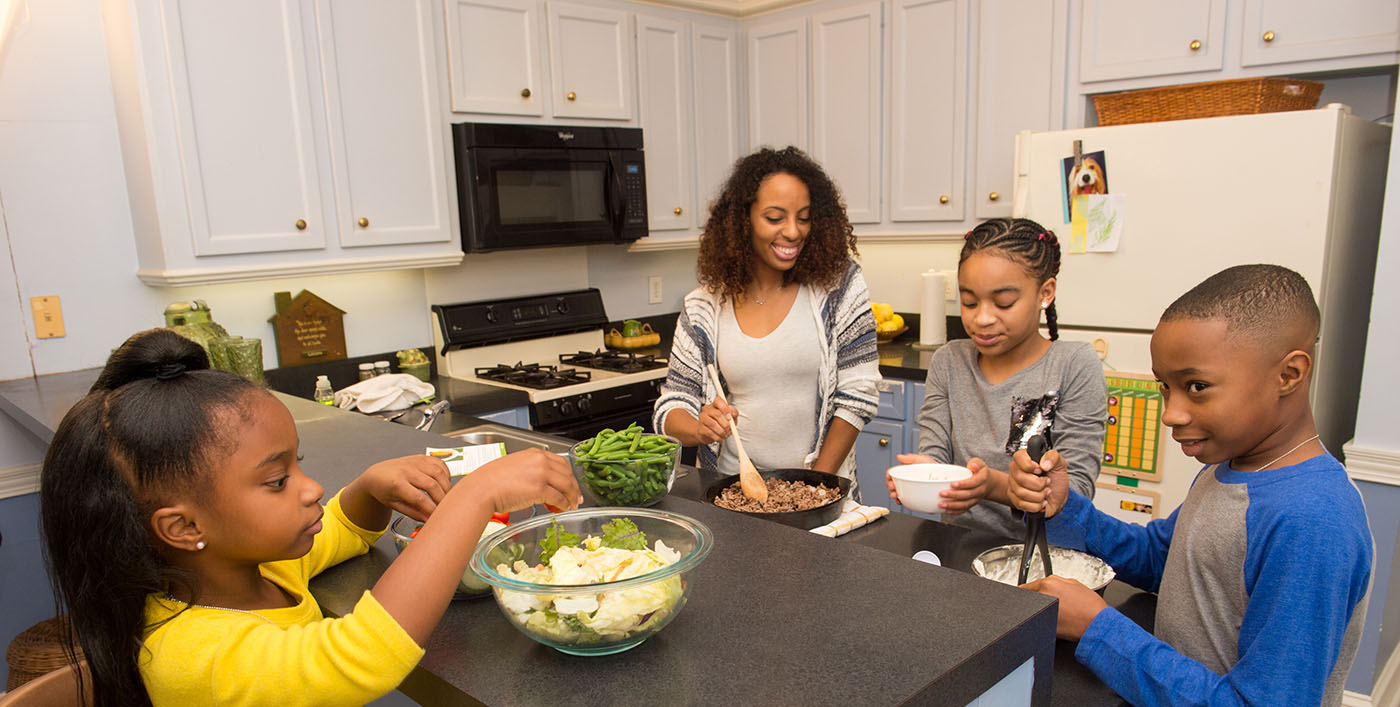
Eat Dinner Together
Life is busy, but it is possible to eat together as a family.
Try fitting in dinner after work or sports practice.
To save time and help scheduling, try creating simple meals. You can even cook and freeze meals the weekend before or whenever you have time, and then heat them up for a quick and tasty meal during the week.
Dinner doesn’t have to be fancy. Eating together is what counts.
How to start
Go slowly. In the beginning, don’t expect your family to eat together every day. It will take time to develop this habit. Try setting a starting goal of one to two times per week.
Start simple. Cook meals ahead of time that you can freeze, reheat, and share with your family at your convenience.
A calm environment. Anything that can disrupt your meal (including electronics like phones, TVs, or video games) should be turned off and put away. Without these distractions, everyone will be more relaxed and concentrated on spending time together.
Involvement. Make sure everyone is involved in the meal process. This includes brainstorming, shopping, cooking, eating, and cleaning.
Relax and connect. Keep dinner conversation fun. Share any and all positive events of the day. Tell jokes and funny stories. Ask each other riddles. Encourage your kids to share things that make them laugh.
The Importance of Family Dinners

The Importance of Family Dinners
Fitting meals around an entire family’s busy schedule makes it hard to have “family dinners” together. However, family mealtime is extremely beneficial for children.
Research suggests that having dinner together four times a week has positive effects on child development. Family dinners have been linked to lower risk of obesity, substance abuse, eating disorders, and an increased chance of graduating from high school.
Conversation
Eating dinner with family provides time for conversation. Parents can teach healthy communication skills without distractions from smart phones, television, computers, or other electronic devices.
Engaging your children in conversation teaches them how to listen and gives them a chance to voice their opinions. This allows your children to have an active voice in the family.
Regular conversation at the dinner table expands a child’s vocabulary and reading ability, regardless of socioeconomic status. Family dinners also allow family members to discuss their day and share news.
- Use these tips to encourage conversation:
- Discuss your child’s day. Express interest in their daily life.
- Discuss current events. Bring up news that’s appropriate for your child’s age.
- Let all family members talk. Be an active listener and be sure your child learns to listen as well.
- Encourage your child to participate. Do not underestimate your child’s ability to hold a conversation.
Developmental Benefits
Family meals provide a sense of security and togetherness that help nurture children into healthy, well-rounded adults. Frequent family dinners have a positive impact on children’s values, motivation, personal identity, and self-esteem.
Children who eat dinner with their family are more likely to understand, acknowledge, and follow the boundaries and expectations set by their parents. A decrease in high-risk behaviors is related to a greater amount of time spent with family—especially during family dinners.
To make the most of your family mealtime, follow these guidelines:
- Turn off electronics during dinner.
- Try to have family dinners four to five times a week.
- Enjoy positive conversation during the meal.
- Spend an hour eating dinner, conversing, and cleaning up together.
Nutritional Benefits
Your children learn healthy eating habits from you; eating dinner together provides a model of healthy eating for children to take with them into adulthood. Studies show that families who eat together increase fruit and vegetable intake; they eat fewer fried foods and drink less soda; and family meal frequency is linked to the intake of protein, calcium, and some vitamins.
Mealtime suggestions:
- Cook as a family and include everyone in the preparation process.
- Experiment with fun recipes.
- Remake old recipes with healthier alternatives.
- Have “theme” cuisine nights such as Italian, Mexican, or Caribbean.
- Know your children’s favorite meals and cook them on a rotating basis.
- Create your own recipes.
Daily family dinners require effort to plan, but their benefits in mental and physical health are more than worth it.
Make Mealtime Family Time
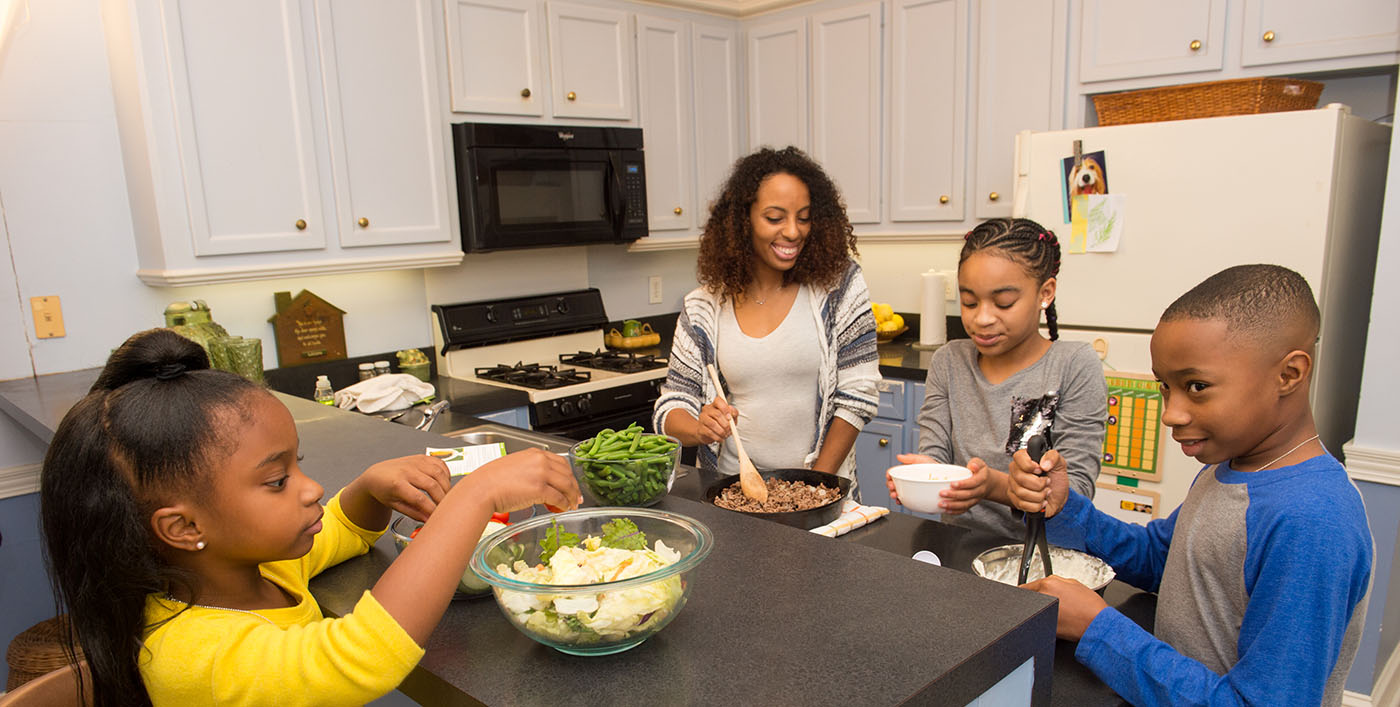
Make Mealtime Family Time
Better Dinner Tips:
- Start early. Start eating meals together when your kids are young. Try to have a family meal a few times a week.
- Let them do it. Let your kids serve themselves at dinner. Teach them to take small amounts first. If they’re still hungry, then they can have more.
- Try something new. Try new foods, but don’t force your child to eat.
- Make time to talk. Focus on the meal and each other. Turn off the TV and take phone calls and texts later.
Tips for Enjoying Favorite Foods
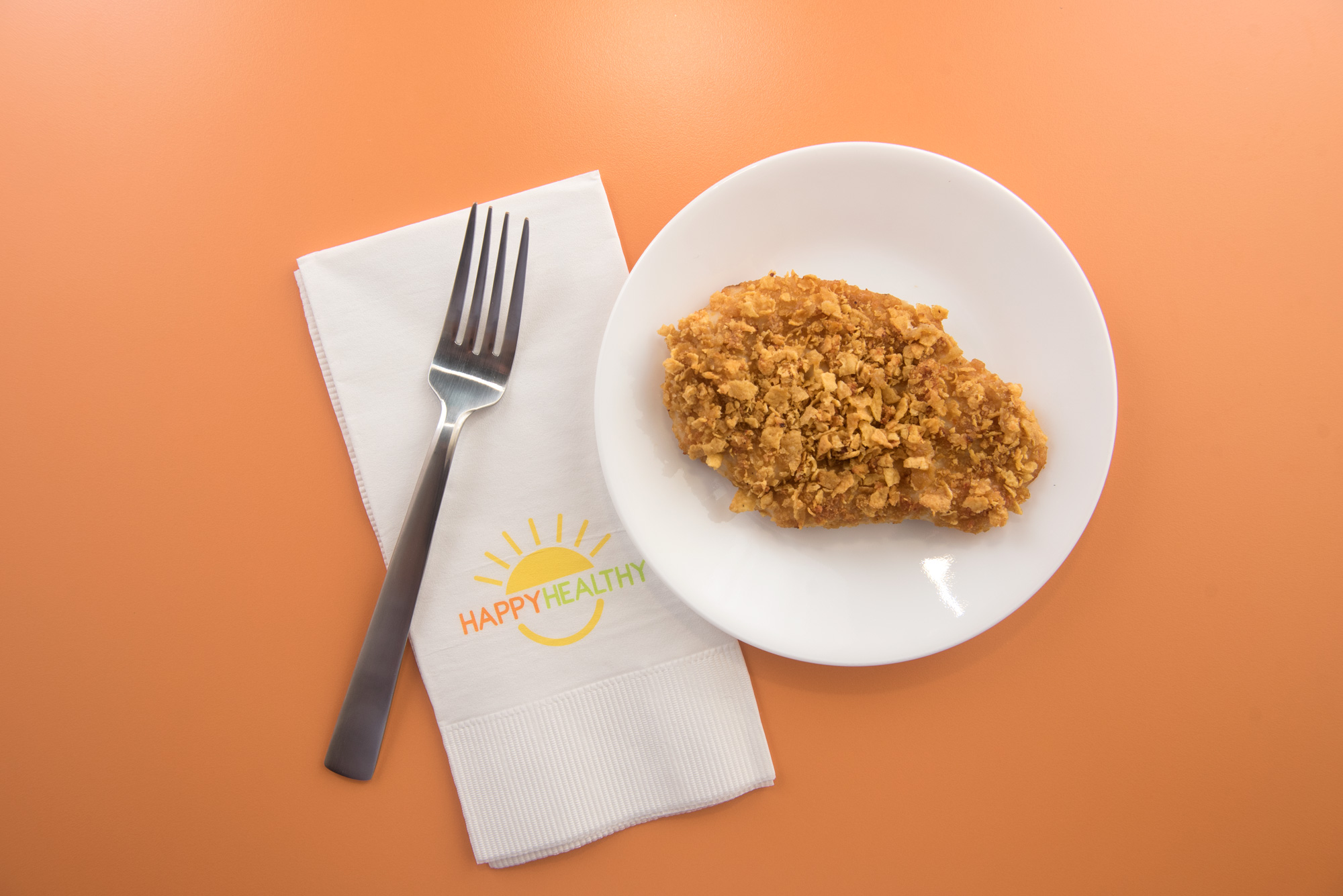
Tips for enjoying favorite foods the HappyHealthy way!
- Bake meats with a crispy coating of breadcrumbs or cornflake crumbs instead of frying.
- Drink ice water with meals instead of sugar-sweetened drinks.
- Use smoked turkey pieces to flavor greens, beans, and peas instead of bacon or fatback.
- Add flavor with herbs and spices, to replace salt and fat.
- Cut out or use less gravy, creamy sauces or salad dressings, or sugary ketchup or barbecue sauces.
- Choose low-sodium or no-salt-added versions of canned or frozen foods.
- Add more veggies to your recipes and your plate.
- Use brown rice or whole-wheat pasta to add nutrition and fiber.
- Enjoy the flavor but reduce the calories with smaller portions.
- Offer fresh fruits or salads full of tasty veggies as side dishes.
A Role Model for Healthy Habits

BUILDING HEALTHY MEALTIME HABITS
BE A HEALTHY ROLE MODEL FOR CHILDREN
10 Tips for Preschoolers
Preschoolers love to copy what their parents do. They mimic your table manners, your willingness to try new foods, and your preferences. Take a break from the TV or phone and build healthy mealtime habits together.
- Plan meals and snacks.
- Make time for three meals and one or two snacks every day. Offer choices from each food group—fruits, vegetables, whole grains, low-fat dairy, and protein foods—throughout the day so your preschooler gets the nutrition he or she needs.
- Make meals enjoyable.
- Eat meals with your children whenever possible. Let them help you prepare the meal. Make conversation about something that made them laugh. Keep mealtime upbeat and stress free.
- Try to get two food groups in a snack.
- Pair sliced tomato with low-fat cottage cheese or add nut butter to a 100% whole-wheat mini bagel.
- Keep things positive.
- Talk about the color, feel, or flavor of foods so they sound appealing to your preschooler. Discourage others from making negative comments about food during meals.
- Develop taste buds.
- When preschoolers develop a taste for many foods, it's easier to plan meals. Keep in mind that it may take a dozen tries for a child to accept a new food.
- Visit the market.
- Shopping can teach your preschooler about food and healthy eating—talk about where foods come from and how they grow.
- Let children practice serving themselves.
- Include smaller cuts of fish or meat and offer small serving utensils so they get just enough during meals. Encourage them to ask for more if they are still hungry.
- Beverages are important, too.
- Water helps to quench your preschooler’s thirst, and milk provides nutrients for growth. Offer water or fat-free or low-fat milk as beverage choices instead of sugary drinks.
- Help them know when they are full.
- Encourage your child to stop eating when he or she is full rather than when the plate is clean. When your child is not interested in the meal, excuse him or her from the table.
- Reward with attention, not treats.
- Rewarding children with sweet desserts or snacks may encourage them to think that treats are better than other foods. Comfort and reward with care and praise, not food.
Brought to you by the United States Department of Agriculture. DG TipSheet No. 38, June 2015.
10 Tips for Setting Good Examples
You are the most important influence on your child. You can do many things to help your children develop healthy eating habits for life. Offering a variety of foods helps children get the nutrients they need from every food group. They will also be more likely to try new foods and to like more foods. When children develop a taste for many types of foods, it’s easier to plan family meals. Cook together, eat together, talk together, and make mealtime a family time!
- Show by example.
- Eat vegetables, fruits, and whole grains with meals or as snacks. Let your child see that you like to munch on raw vegetables.
- Go food shopping together.
- Grocery shopping can teach your child about food and nutrition. Discuss where vegetables, fruits, grains, dairy, and protein foods come from. Let your children make healthy choices.
- Get creative in the kitchen.
- Cut food into fun and easy shapes with cookie cutters. Name a food your child helps make. Serve “Janie’s Salad” or “Jackie’s Sweet Potatoes” for dinner. Encourage your child to invent new snacks. Make your own trail mixes from dry whole-grain, low-sugar cereal, and dried fruit.
- Offer the same foods for everyone.
- Stop being a “short-order cook” by making different dishes to please children. It’s easier to plan family meals when everyone eats the same foods.
- Reward with attention, not food.
- Show your love with hugs and kisses. Comfort with hugs and talks. Choose not to offer sweets as rewards. It lets your child think sweets or dessert foods are better than other foods. When meals are not eaten, kids do not need “extras”—such as candy or cookies—as replacement foods.
- Focus on each other at the table.
- Talk about fun and happy things at mealtime. Turn off the television. Take phone calls later. Try to make eat meals a stress-free time.
- Listen to your child.
- If your child says he or she is hungry, offer a small, healthy snack—even if it is not a scheduled time to eat. Ask “Which would you like for dinner: broccoli or cauliflower?” instead of “Do you want broccoli for dinner?”
- Limit screen time.
- Allow no more than 2 hours a day of screen time like TV and computer games. Get up and move during commercials to get some physical activity.
- Encourage physical activity
- Make physical activity fun for the whole family. Involve your children in the planning. Walk, run, and play with your child—instead of sitting on the sidelines. Set an example by being physically active and using safety gear, like bike helmets.
- Be a good food role model.
- Try new foods yourself. Describe it taste, texture, and smell. Offer one new food at a time. Serve something your child likes along with the new food. Offer new foods at the beginning of a meal, when your child is hungry. Avoid lecturing or forcing your child to eat.
Brought to you by the United State Department of Agriculture. DG TipSheet No. 12, June 2011.
Picky Eaters and How to Deal with Them

Picky Eaters and How to Deal with Them
Does this sound familiar?
“He doesn’t eat anything green.”
“My daughter won’t eat food that’s mixed together.”
“She doesn’t like soup.”
You can handle your fussy eaters! Try these tips to help your eaters be a little less picky. Before you know it, they’ll eat anything.
You may be familiar with phrases like: “Thomas only eats chicken nuggets and fries when we go out to eat,” or “Eliza will only eat white foods.” Your child may refuse to eat some types of foods based on their color or texture. This behavior is common between the ages of 2 and 5. Even though your child may be picky, they are probably still healthy if they have plenty of energy and are growing. If you are concerned about their nutrition, talk to your doctor.
Tips for Picky Eaters
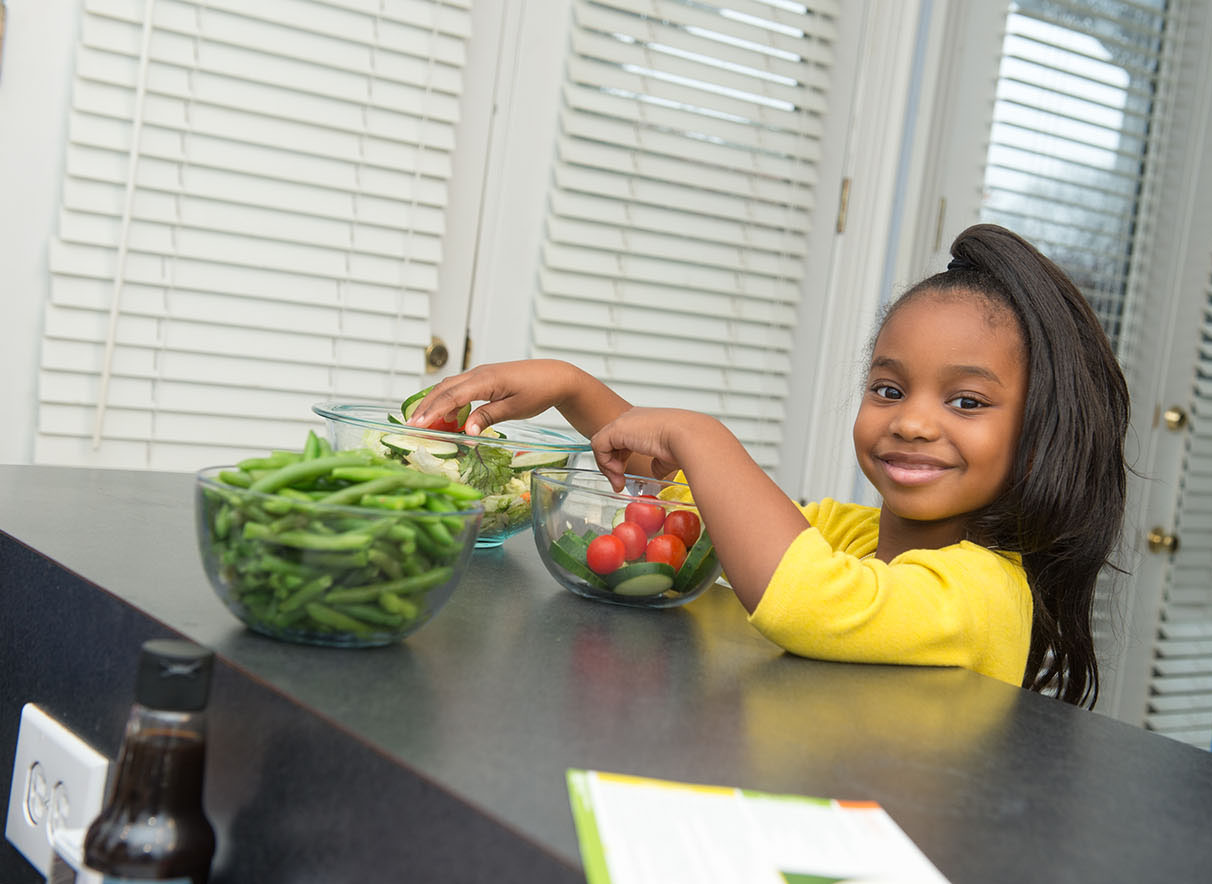
Tips for Picky Eaters
Keep Trying. Offer a new food multiple times.
- If your child doesn’t want new food, that’s okay! You can always try it again later.
- Many kids need to see and taste a new food several times (15 or more!) before they learn to like it.
Kids learn to like new foods by:
- Having them offered over and over.
- Having them served with familiar foods.
- Seeing friends, older kids, and grown-up eating these foods.
- Tasting them prepared in different ways.
- Picking out their food from 2 healthy choices that you offer.
- Starting with small amounts.
Try new foods in different ways:
- Serve fruits and vegetables raw with a side of dip.
- Steam, roast, and bake veggies—and fruits, too!
- Warm fruits like apples, pears, and peaches for a softer texture.
- Try frozen or canned fruit—but make sure to find ones packed in 100% juice or water.
Taste new vegetables:
- If your children are unsure of vegetables, top them with cheese sauces, peanut sauces, ranch dips, and pesto to make them more appealing.
- Mix vegetables with foods that your kids already like.
- Try vegetables as pizza toppings for more color and flavor!
- Hide vegetables in mash potatoes or in sauces like spaghetti sauce.
- If you find a vegetable that they like, keep serving it!
What does your child eat?
- Knowing what tastes your child prefers can help you figure out which new foods they might prefer.
- If your child likes sweet foods, try sweet tasting vegetables like carrots, parsnips, or beets.
- If your child enjoys bananas, they might like other soft fruits like avocados. They may also enjoy soft canned fruits and vegetables.
- Get more good ideas from these sources:
Provide many healthy options, but let kids serve themselves.
- Kids like to make choices. Let them do that by providing many healthy options that they can choose from.
- Start out small. Give them a spoonful. If they like it, they can get more.
- Let children eat how much they would like—whether that be a lot or a little. Forcing them to eat a certain amount will not create a fondness for the food.
- Have fresh fruit ready to eat:
- Chop and store fruit in the refrigerator.
- Store whole fruits on the counter.
- Have canned fruits in the pantry.
- Keep salad or easy-to-grab vegetables in the fridge during the week.
- Store frozen vegetables in the freezer and microwave later.
- Cookies and crackers can be an occasional treat.
Every child is different.
- Every kid has different tastes, just like every adult. Some children will be adventurous, and others will need time to get used to new foods. Patience is the key!
- Because all kids have different tastes, you shouldn’t compare your child’s preferences to others of the same age.
Coping with Picky Eaters

Coping with Picky Eaters
Children will grow out of their picky habits, especially if you do not make a big deal out of them. Usually, picky eating habits end before school age. The following are some tips to help deal with your child’s habits in a positive way:
- If children have the opportunity to pick out their own foods (especially fruits and vegetables), they are more likely to eat the foods.
- Cook with your child. This is the perfect time for your child to learn about foods and get to taste them. Let your child clean fresh produce, add ingredients, and stir.
- Give them options. For example, don’t ask your children if they want one vegetable; ask them to pick between two options you give them.
- Make sure your time at the table is positive and not stressful. If children associate meal times with arguments or stressful situations, they may develop unhealthy attitudes toward food.
- Make the same meal for everyone. Don’t go out of your way to humor your child’s picky habits. Even if your child misses a meal every now and then, he or she will be OK.
Trying New Foods

Trying New Foods
Your child may find it hard to try new foods, which is very normal. The following are tips to help your child explore new foods:
- Small portions first. Let children try small portions of food until they warm up to it.
- One food at a time. Offer only one new food at a time so your child doesn’t become overwhelmed.
- Be a role model. Try new foods yourself to encourage your child. Make sure to describe the food to your child.
- New foods first. At the beginning of a meal, children are hungrier. This is the time to serve new foods.
- It takes time. It can take children many tries before they warm up to a new food. Don’t stop trying.
Making Food Fun

Making Food Fun
Getting children interested in cooking is one way to expand their food tastes. Make sure to include your children in cooking. The following are creative ideas to get your child involved in the kitchen:
- Use a cookie cutter to cut foods into fun shapes.
- Work with children to invent new combinations for snacks and let them help you create them.
- Give children credit for foods that they create. For example, name the food after your child (“Brianna’s pasta,” “Joseph’s salad”).